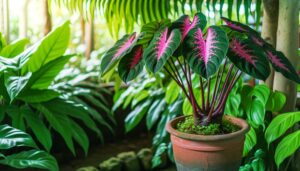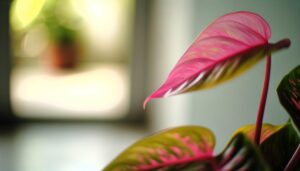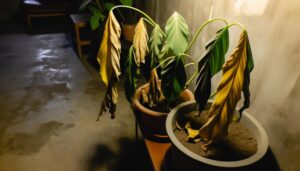What Are the Characteristics of Philodendron Erubescens 'Black Cardinal'?
Philodendron erubescens 'Black Cardinal' is a tropical aroid characterized by its striking, deep burgundy to almost black, glossy, leathery leaves. Originating from South America's rainforests, this plant has a compact, bushy growth habit and thrives in low-light conditions.
It requires bright, indirect sunlight and consistently moist, well-draining soil. Regular pruning and fertilization promote its health and aesthetic appeal.
This philodendron is susceptible to pests like spider mites and diseases such as root rot. Propagation is typically achieved through stem cuttings under high humidity.
For an in-depth understanding of its care and maintenance, continue exploring.
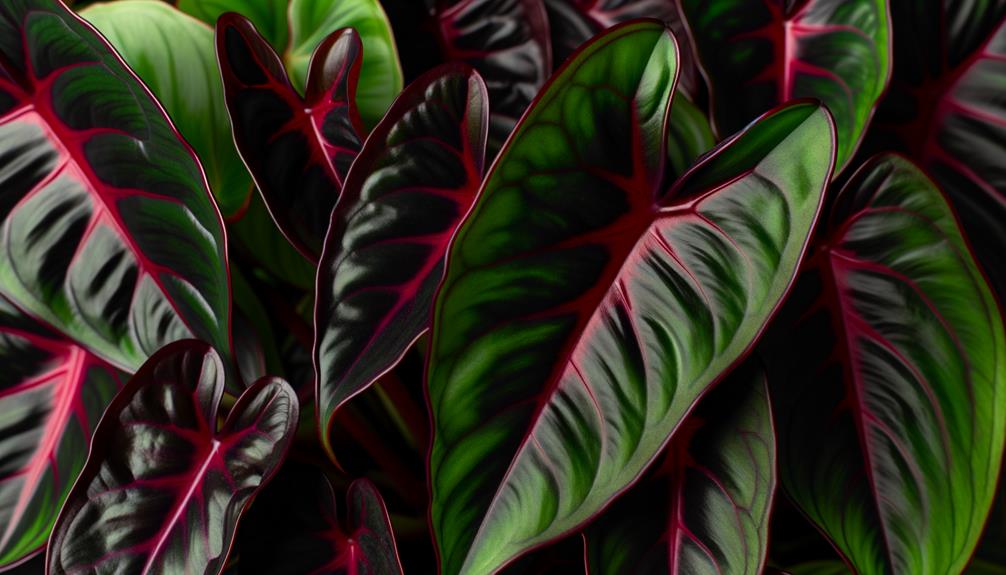
Key Takeaways
- Exhibits deep burgundy to nearly black, glossy, leathery, heart-shaped leaves.
- Grows upright with a compact, bushy form and thick, self-supporting stems.
- Thrives in bright, indirect light and filtered sunlight; direct sunlight can damage leaves.
- Requires consistently moist, well-draining soil and high humidity (60-80%).
- Benefits from balanced fertilization every 4-6 weeks with a 20-20-20 water-soluble fertilizer.
Origin and History

Philodendron erubescens 'Black Cardinal' originated in tropical regions of South America, where it developed its distinctive dark foliage and robust growth habits. Belonging to the Araceae family, this species flourishes in the humid, shaded understory of rainforests.
Its natural habitat, characterized by high humidity and consistent temperatures, has influenced its adaptive traits, such as tolerance to low light conditions. The plant's sturdy, upright growth is a result of evolutionary pressures to compete for sunlight amidst dense vegetation.
Philodendron erubescens was first classified by Heinrich Wilhelm Schott in the 19th century, with subsequent cultivars like 'Black Cardinal' emerging from horticultural advancements. This cultivar's introduction into ornamental horticulture has enhanced its popularity among enthusiasts seeking unique, low-maintenance houseplants.
Leaf Color and Texture
Concerning leaf color and texture, the 'Black Cardinal' cultivar exhibits a striking deep burgundy to nearly black hue, with a glossy, leathery surface that enhances its visual appeal. The Philodendron erubescens 'Black Cardinal' is characterized by its large, heart-shaped leaves that exhibit a resilient texture, providing a robust structure and a sleek, reflective finish. The pigmentation of the leaves intensifies with age, shifting from a lighter burgundy in new growth to a near-black tone in mature foliage. Additionally, the leaf surface is smooth, contributing to the plant's sophisticated appearance.
| Leaf Aspect | Description | Notable Features |
|---|---|---|
| Color | Deep burgundy to nearly black | Enhances visual appeal |
| Texture | Glossy, leathery | Robust and reflective |
| Shape and Size | Large, heart-shaped | Provides structure |
This cultivar's unique leaf characteristics make it a distinctive addition to any collection.
Growth Habit
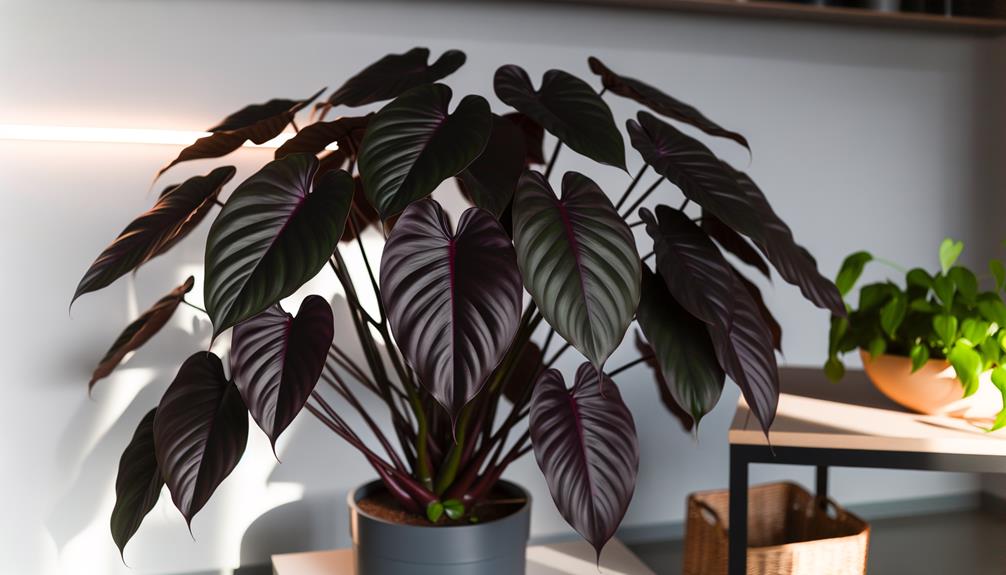
Philodendron erubescens 'Black Cardinal' exhibits an upright growth pattern, characterized by its compact and bushy form.
This cultivar demonstrates a moderate growth rate, making it a suitable choice for both indoor and controlled outdoor environments.
Understanding these growth dynamics is essential for effective cultivation and maintenance of this ornamental plant.
Upright Growth Pattern
Exhibiting a robust upright growth pattern, Philodendron erubescens 'Black Cardinal' maintains its vertical stature through the support of its thick, self-supporting stems. This structural rigidity is a hallmark of its morphological design, facilitating an impressive upright posture that distinguishes it from other Philodendron species.
The plant's stems are composed of densely packed vascular tissues, providing both strength and nutrient transport efficiency. The large, elliptic leaves, typically dark green to nearly black, emerge at acute angles, contributing to its vertical alignment. Such an arrangement optimizes light capture and photosynthetic efficiency.
Moreover, the orthotropic growth habit minimizes spatial competition, allowing 'Black Cardinal' to thrive in confined environments, making it a favored choice for indoor horticulture.
Moderate Growth Rate
Adopting a moderate growth rate, Philodendron erubescens 'Black Cardinal' balances its development, ensuring sustainable expansion without rapid overgrowth. This characteristic makes it an ideal choice for both novice and experienced horticulturists seeking manageable maintenance.
In comparison to other Philodendron species, 'Black Cardinal' exhibits a slower vegetative proliferation, characterized by the gradual emergence of its striking, dark-hued foliage. This controlled growth mitigates the risk of overcrowding in confined spaces, such as indoor environments or limited garden plots.
The plant's moderate rate also allows for more predictable care routines, reducing the frequency of repotting and pruning. Ultimately, the measured growth habit of Philodendron erubescens 'Black Cardinal' aligns well with its ornamental appeal, facilitating long-term cultivation and aesthetic enjoyment.
Light Requirements
Best growth of Philodendron erubescens 'Black Cardinal' necessitates bright, indirect light conditions to prevent leaf scorch and uphold vibrant foliage. This plant flourishes in environments where it can receive filtered sunlight, resembling its native tropical understory habitat. Direct sunlight exposure can result in chlorosis or leaf burn, notably diminishing the aesthetic appeal and health of the plant.
Key considerations for ideal light conditions include:
- Filtered Light: Utilize curtains or blinds to scatter intense sunlight.
- Artificial Lighting: Complement with fluorescent or LED grow lights in low-light environments.
- Light Duration: Guarantee a consistent light period of 12-16 hours daily.
Comprehending these light requirements is essential for preserving the decorative value and physiological health of Philodendron erubescens 'Black Cardinal'.
Watering Needs
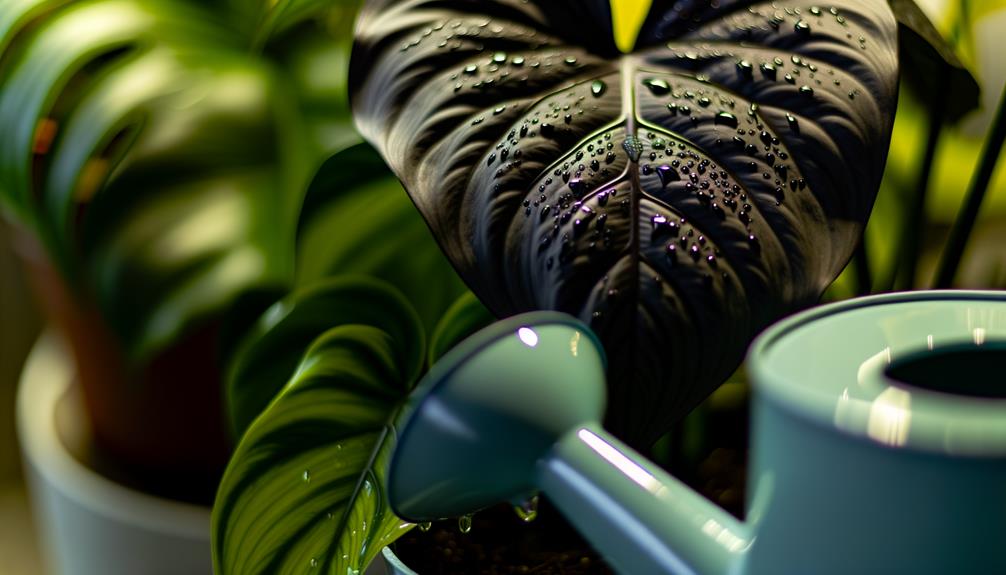
Proper hydration is critical for the Philodendron erubescens 'Black Cardinal', which thrives in consistently moist but not waterlogged soil. Maintaining ideal moisture levels involves regular watering, ensuring the top inch of soil dries out between applications to prevent root rot.
Overwatering poses significant risks, including fungal infections and oxygen deprivation in the root system.
Ideal Moisture Levels
Philodendron erubescens 'Black Cardinal' flourishes in consistently moist, well-draining soil, requiring regular watering to maintain ideal hydration without waterlogging. Ensuring the substrate remains appropriately moist is vital for best growth. Observing the following guidelines will support this goal:
- Frequency: Water when the top inch of soil feels dry to the touch.
- Quality: Use room-temperature, filtered water to avoid chlorine and fluoride damage.
- Technique: Water thoroughly until excess drains from the bottom, ensuring even moisture distribution.
This balance prevents the detrimental effects of both desiccation and water saturation.
Monitoring humidity levels is equally important, as Philodendron erubescens 'Black Cardinal' favors a humid environment, ideally between 60-80%.
Employing these practices will facilitate a strong and healthy plant.
Overwatering Risks
Excessive watering of Philodendron erubescens 'Black Cardinal' can lead to root rot. This condition is caused by waterlogged soil that deprives roots of necessary oxygen and fosters pathogenic fungi. The phenomenon primarily results from the plant's inability to efficiently absorb water and nutrients, leading to weakened growth and potential plant death.
Indicators of root rot include yellowing leaves, wilting, and a foul odor emanating from the soil. To mitigate these risks, it is critical to maintain well-draining soil, such as a mix containing peat and perlite, and to allow the top inch of soil to dry out between waterings.
Regularly inspecting the plant for early symptoms can prevent irreversible damage, guaranteeing the Philodendron erubescens 'Black Cardinal' remains healthy and robust.
Soil Preferences
A well-draining, nutrient-rich potting mix is essential for the best growth of Philodendron erubescens 'Black Cardinal.' This plant thrives in substrates that balance moisture retention with aeration. A mix containing peat, perlite, and orchid bark can meet these requirements, promoting root health and growth. The soil pH should ideally range between 5.5 and 6.5, slightly acidic, to optimize nutrient uptake.
Key components for an effective soil mix encompass:
- Peat moss: Enhances moisture retention while remaining lightweight.
- Perlite: Improves drainage and aeration, preventing root rot.
- Orchid bark: Provides essential structure and mimics the plant's natural epiphytic environment.
Regularly checking and amending the soil ensures the Philodendron erubescens 'Black Cardinal' remains vigorous and healthy.
Temperature and Humidity
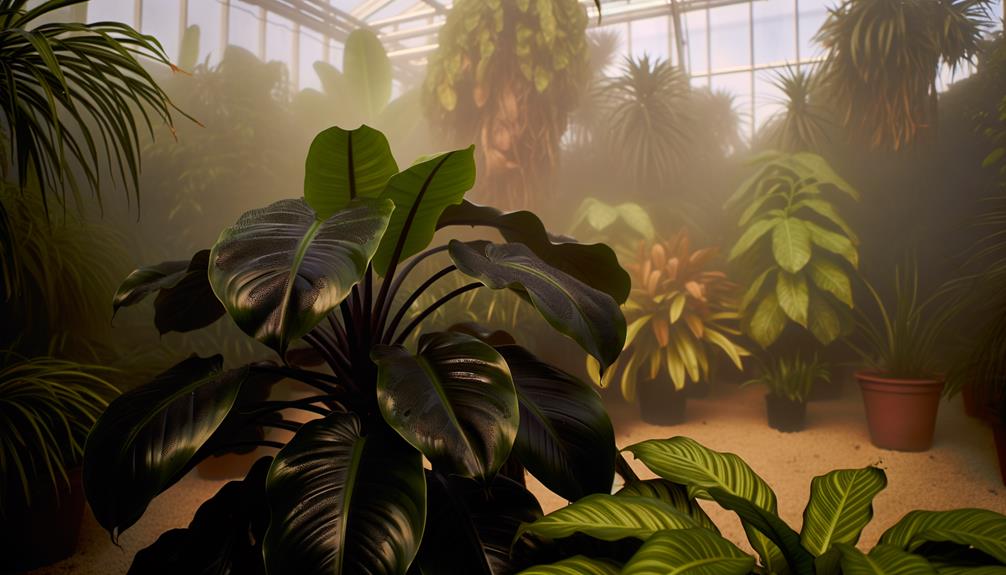
Maintaining an ideal temperature range of 18-27°C (65-80°F) and high humidity levels of 60-80% is crucial for the vigorous growth of Philodendron erubescens 'Black Cardinal'. This tropical species thrives under conditions that mimic its native habitat in Central and South America.
Deviation from these parameters can result in stunted growth and reduced foliar vitality. When ambient temperatures fall below 15°C (59°F), the plant may experience stress, leading to chlorosis and increased susceptibility to pests. Conversely, temperatures exceeding 30°C (86°F) can cause dehydration and leaf scorch.
To maintain vital humidity, regular misting or the use of a humidifier is recommended. Ensuring these environmental conditions will promote lush, healthy foliage and robust plant development.
Fertilization
In addition to ideal temperature and humidity, proper fertilization is fundamental for sustaining the robust growth of Philodendron erubescens 'Black Cardinal'. This species thrives when provided with a balanced, water-soluble fertilizer during its active growing season, typically spring through early fall. The use of a fertilizer with an equal ratio of nitrogen, phosphorus, and potassium (e.g., 20-20-20) is recommended.
Key points to keep in mind for best fertilization practices include:
- Frequency: Apply fertilizer every 4-6 weeks to prevent nutrient deficiencies.
- Dilution: Use a half-strength solution to avoid root burn and excessive fertilization.
- Timing: Stop fertilization during the dormant winter months to align with the plant's natural growth cycle.
Following these guidelines guarantees the Philodendron erubescens 'Black Cardinal' maintains its vibrant foliage and overall health.
Pruning and Maintenance
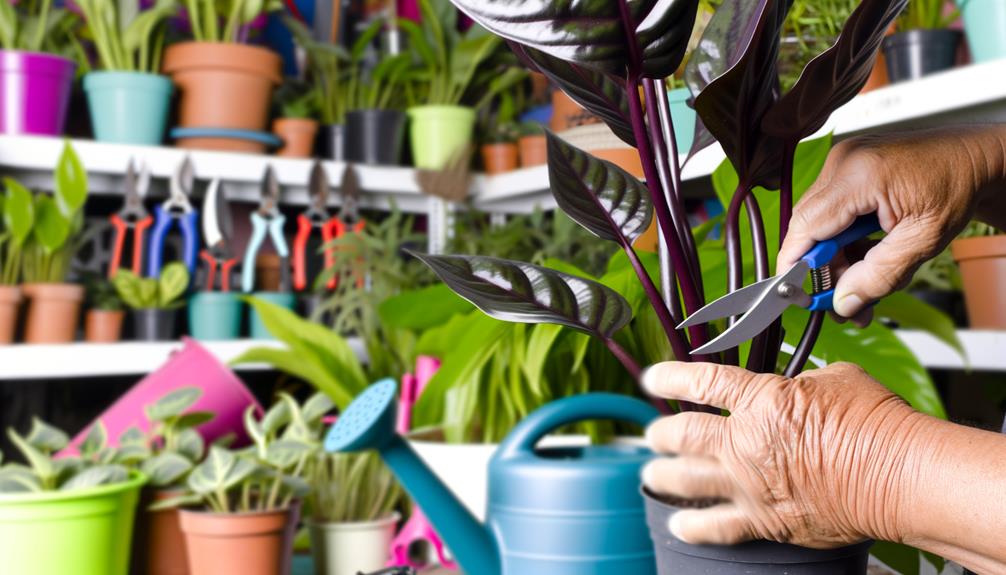
Efficient pruning and maintenance of Philodendron erubescens 'Black Cardinal' require the use of sterilized, sharp pruning shears to prevent disease transmission and ensure clean cuts.
Best pruning techniques involve removing dead or damaged leaves and stems to promote healthy growth and aesthetic form.
Regular assessment and maintenance are essential for sustaining the plant's vigorous development and ornamental appeal.
Essential Pruning Tools
To maximize growth and health of Philodendron erubescens 'Black Cardinal', precise and reliable pruning tools such as bypass pruners, sterilized scissors, and pruning saws are essential. These instruments ensure clean cuts, reducing the risk of disease and promoting optimal plant vitality.
- Bypass pruners: Ideal for cutting live stems, providing a clean, precise cut.
- Sterilized scissors: Vital for smaller, delicate pruning tasks, preventing pathogen transmission.
- Pruning saws: Necessary for thicker branches, offering a smooth cut without damaging plant tissue.
High-quality tools maintain the structural integrity and aesthetic form of Philodendron erubescens 'Black Cardinal'. Proper maintenance and sterilization of these tools further mitigate the spread of pests and diseases, ensuring robust plant health.
Optimal Pruning Techniques
Proper pruning techniques are essential for maintaining the health and aesthetic appeal of Philodendron erubescens 'Black Cardinal', ensuring that the plant thrives in various environmental conditions.
Pruning should be conducted using sterilized, sharp pruning shears to minimize plant stress and prevent pathogen introduction. Focus on removing yellowing or damaged leaves and stems to promote new growth and improve air circulation. Prune at a 45-degree angle just above a node to encourage branching and fuller foliage.
Regularly inspect the plant for signs of disease or pest infestation, and promptly remove affected parts. Seasonal pruning, particularly in spring, can also help manage the plant's size and shape, ensuring best light penetration and robust development of Philodendron erubescens 'Black Cardinal'.
Common Pests and Diseases
Although generally resilient, Philodendron erubescens 'Black Cardinal' is susceptible to common pests such as spider mites (Tetranychidae), mealybugs (Pseudococcidae), and aphids (Aphidoidea), as well as diseases like bacterial leaf spot (Xanthomonas campestris) and root rot caused by overwatering. Effective management of these issues requires routine inspection and prompt intervention.
Common indicators of infestation or disease include:
- Yellowing leaves: Often a sign of nutrient deficiency, pest infestation, or overwatering.
- Wilting or drooping foliage: Can indicate root rot or inadequate water drainage.
- Sticky residue on leaves: Typically a byproduct of aphid or mealybug activity.
Implementing integrated pest management (IPM) strategies, maintaining ideal humidity, and ensuring proper watering practices are essential for minimizing these risks.
Propagation Methods
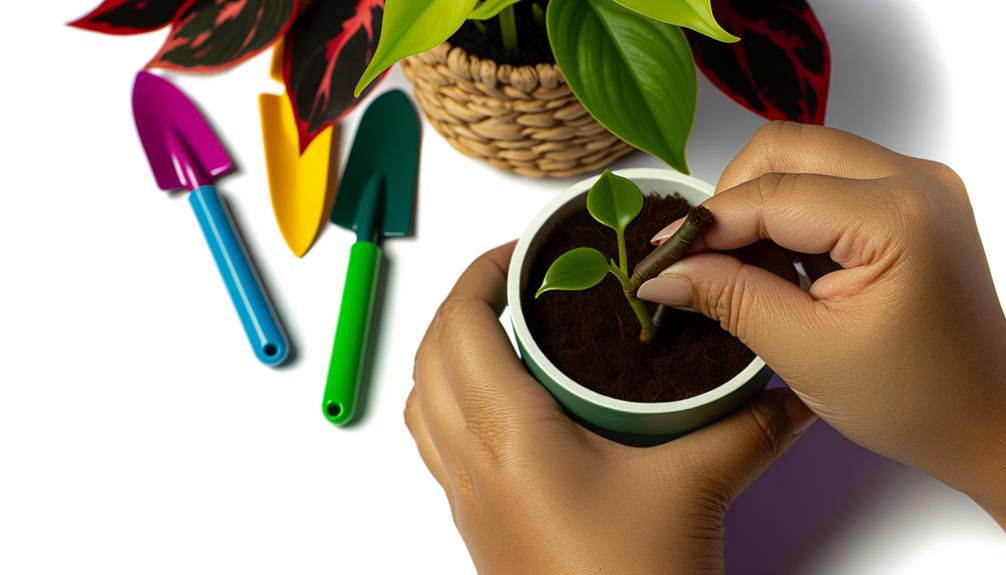
Propagation of Philodendron erubescens 'Black Cardinal' can be effectively achieved through stem cuttings. This process involves selecting a healthy section of the plant with at least one node and leaf. The chosen cutting should be cleanly severed using sterilized pruning shears to prevent disease transmission. It is advisable to allow the cut end to dry and callous for a few hours before planting in a well-draining potting mix.
Ideal rooting conditions include maintaining high humidity and a temperature range between 20-25°C. Root development can be observed within 4-6 weeks. Alternatively, water propagation is also viable. In this method, the cutting is placed in water until sufficient root growth is observed before transferring to soil.
Conclusion
In the verdant tapestry of botanical marvels, Philodendron erubescens 'Black Cardinal' emerges as a paragon of horticultural mastery. Its deep, ebony foliage represents the quiet strength and resilience found in nature's most shaded corners.
Like an ancient manuscript, meticulously scribed, this plant demands precise care and understanding. Its needs echo the delicate balance of ecosystems, where light, water, and nutrients must be harmoniously aligned. Therefore, 'Black Cardinal' serves as a living allegory of nature's intricate symphony.

